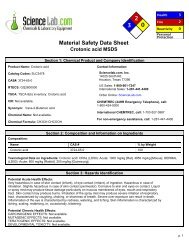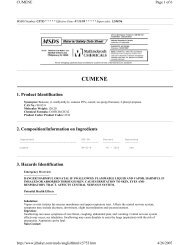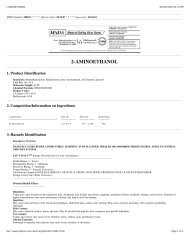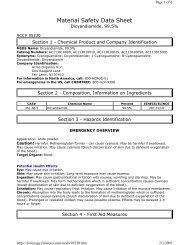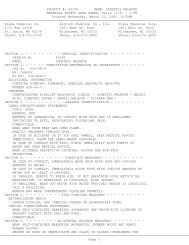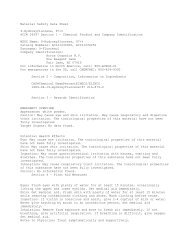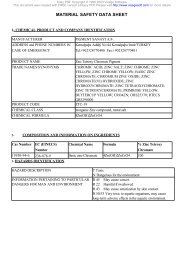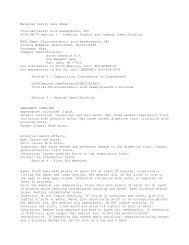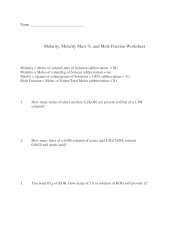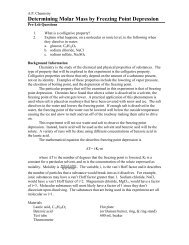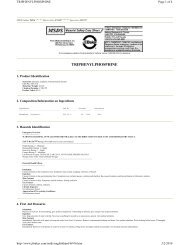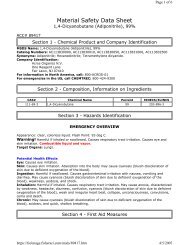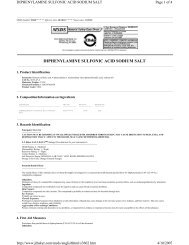You also want an ePaper? Increase the reach of your titles
YUMPU automatically turns print PDFs into web optimized ePapers that Google loves.
The substance is toxic to lungs, mucous membranes.<br />
Repeated or prolonged exposure to the substance can produce target organs damage. Repeated exposure of the<br />
eyes to a low level of dust can produce eye irritation. Repeated skin exposure can produce local skin destruction,<br />
or dermatitis. Repeated inhalation of dust can produce varying degree of respiratory irritation or lung damage.<br />
Section 4: First Aid Measures<br />
Eye Contact:<br />
Check for and remove any contact lenses. Immediately flush eyes with running water for at least 15 minutes,<br />
keeping eyelids open. Cold water may be used. Do not use an eye ointment. Seek medical attention.<br />
Skin Contact:<br />
If the chemical got onto the clothed portion of the body, remove the contaminated clothes as quickly as possible,<br />
protecting your own hands and body. Place the victim under a deluge shower. If the chemical got on the victim's<br />
exposed skin, such as the hands : Gently and thoroughly wash the contaminated skin with running water and<br />
non-abrasive soap. Be particularly careful to clean folds, crevices, creases and groin. Cold water may be used.<br />
If irritation persists, seek medical attention. Wash contaminated clothing before reusing.<br />
Serious Skin Contact:<br />
Wash with a disinfectant soap and cover the contaminated skin with an anti-bacterial cream. Seek immediate<br />
medical attention.<br />
Inhalation: Allow the victim to rest in a well ventilated area. Seek immediate medical attention.<br />
Serious Inhalation:<br />
Evacuate the victim to a safe area as soon as possible. Loosen tight clothing such as a collar, tie, belt or<br />
waistband. If breathing is difficult, administer oxygen. If the victim is not breathing, perform mouth-to-mouth<br />
resuscitation. WARNING: It may be hazardous to the person providing aid to give mouth-to-mouth resuscitation<br />
when the inhaled material is toxic, infectious or corrosive. Seek immediate medical attention.<br />
Ingestion:<br />
Do not induce vomiting. Examine the lips and mouth to ascertain whether the tissues are damaged, a possible<br />
indication that the toxic material was ingested; the absence of such signs, however, is not conclusive. Loosen<br />
tight clothing such as a collar, tie, belt or waistband. If the victim is not breathing, perform mouth-to-mouth<br />
resuscitation. Seek immediate medical attention.<br />
Serious Ingestion: Not available.<br />
Section 5: Fire and Explosion Data<br />
Flammability of the Product: May be combustible at high temperature.<br />
Auto-Ignition Temperature: 476.67°C (890°F)<br />
Flash Points: CLOSED CUP: 103.33°C (218°F).<br />
Flammable Limits: LOWER: 1.4% UPPER: 7.1%<br />
Products of Combustion: These products are carbon oxides (CO, CO2).<br />
Fire Hazards in Presence of Various Substances: Not available.<br />
Explosion Hazards in Presence of Various Substances:<br />
Risks of explosion of the product in presence of mechanical impact: Not available.<br />
Risks of explosion of the product in presence of static discharge: Not available.<br />
Fire Fighting Media and Instructions:<br />
SMALL FIRE: Use DRY chemical powder.<br />
LARGE FIRE: Use water spray, fog or foam. Do not use water jet.<br />
p. 2



